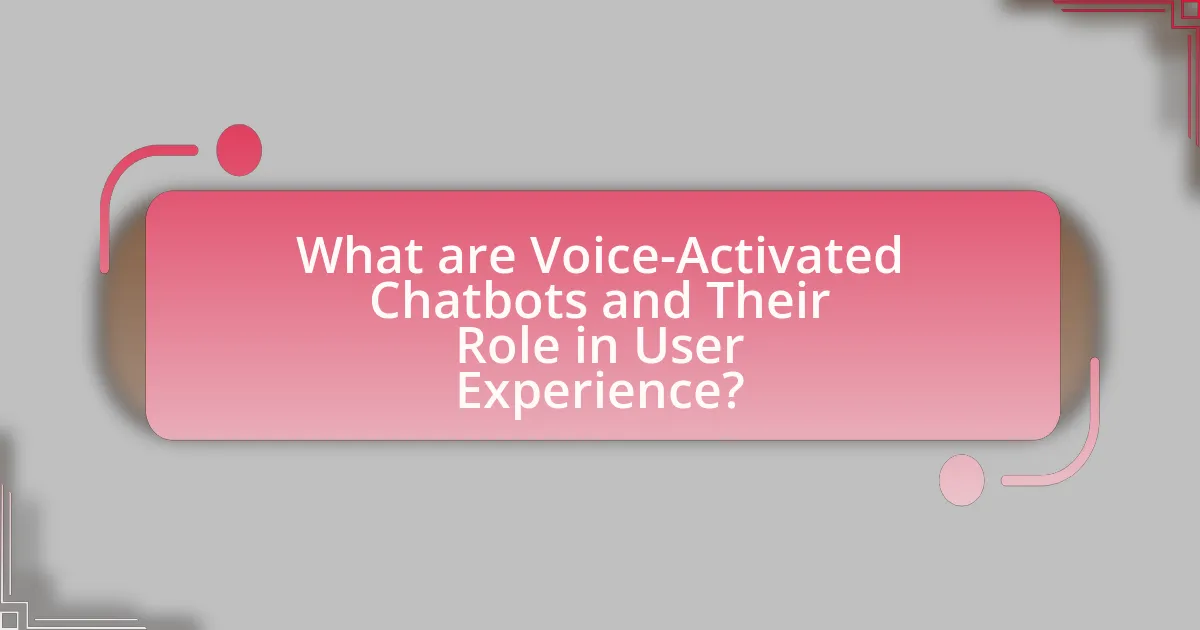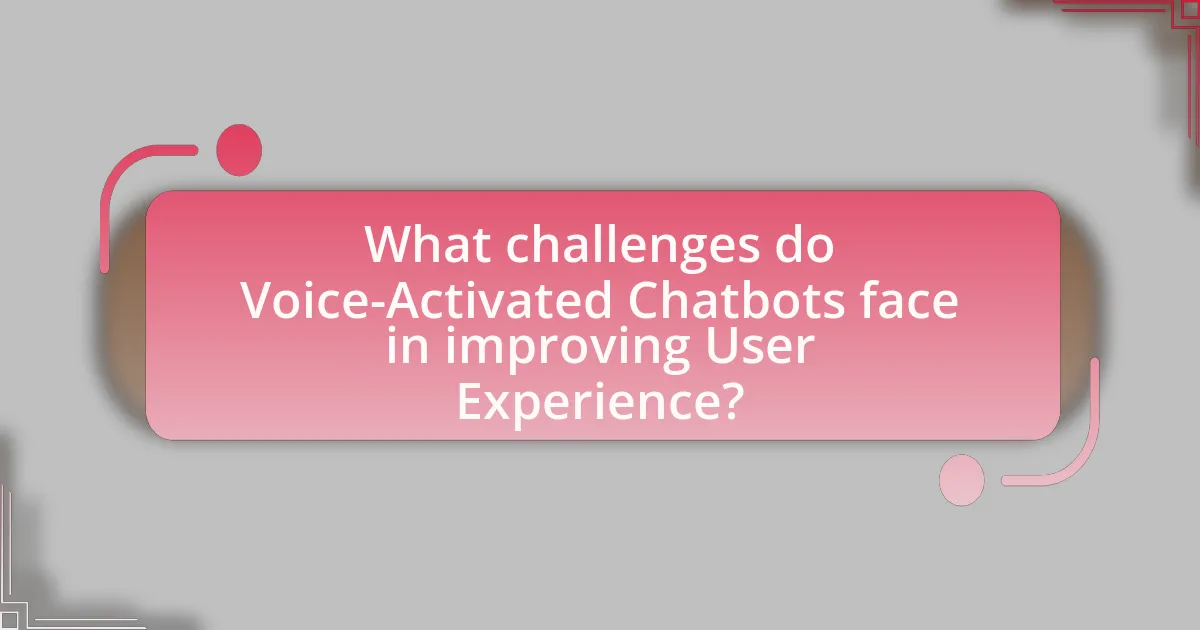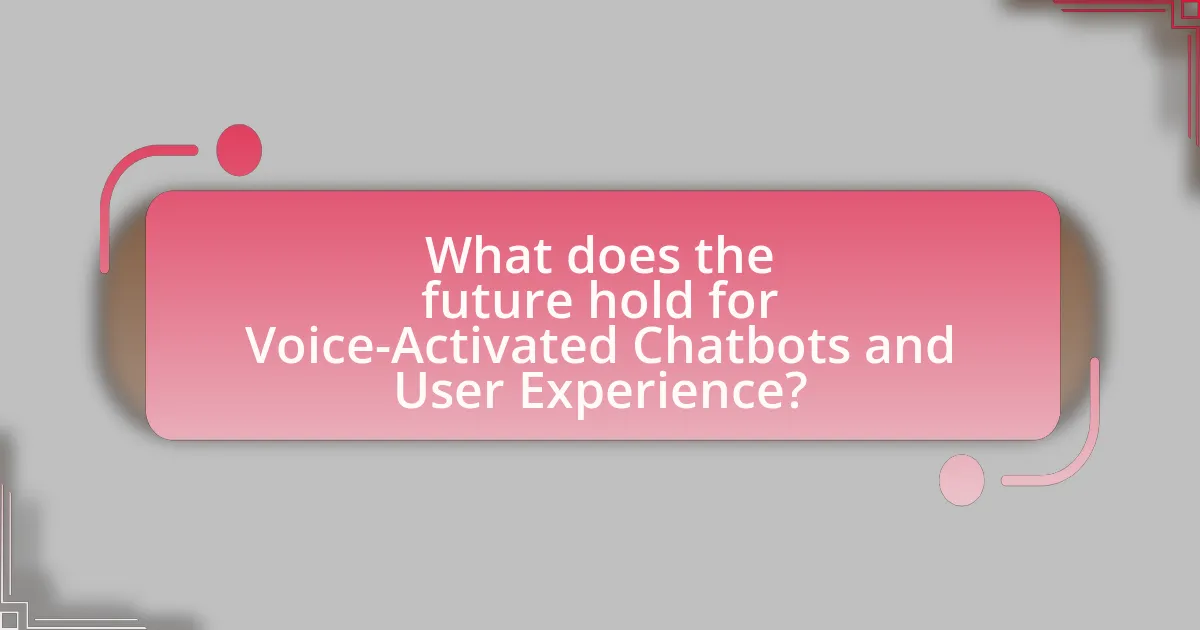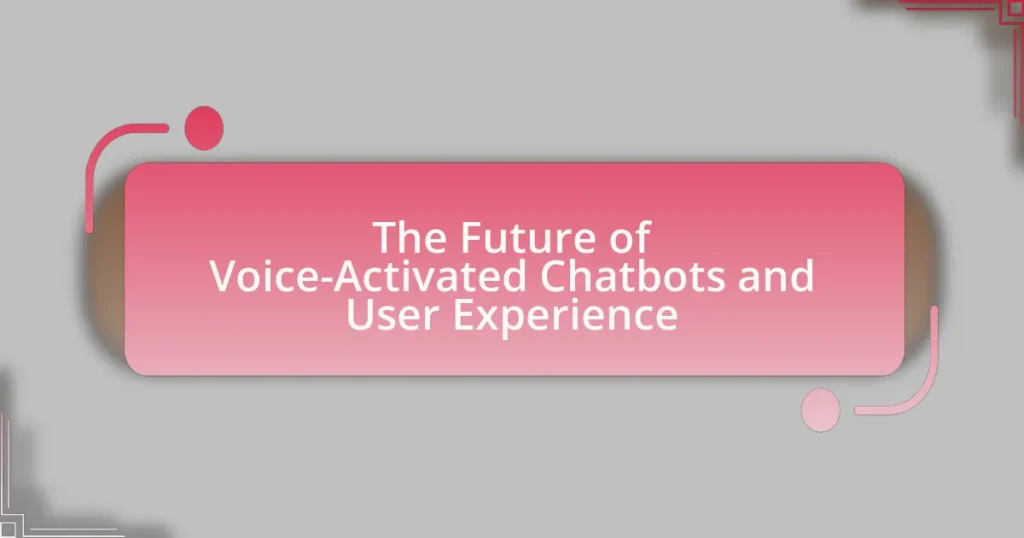Voice-activated chatbots are advanced artificial intelligence systems that utilize voice recognition technology to facilitate spoken interactions with users. This article explores their role in enhancing user experience by providing hands-free communication, improving accessibility, and increasing convenience. Key topics include the functioning of these chatbots through automatic speech recognition and natural language processing, the technologies that enable their effectiveness, and the importance of user experience design. Additionally, the article addresses current trends, challenges, and future advancements in voice-activated chatbots, emphasizing the significance of user feedback and privacy concerns in shaping user trust and engagement.

What are Voice-Activated Chatbots and Their Role in User Experience?
Voice-activated chatbots are artificial intelligence systems that use voice recognition technology to interact with users through spoken language. These chatbots enhance user experience by providing hands-free, efficient communication, allowing users to engage with services or information seamlessly while multitasking. According to a study by PwC, 71% of consumers prefer using voice assistants for quick tasks, highlighting the growing demand for voice-activated interactions. This preference indicates that voice-activated chatbots significantly improve accessibility and convenience, making them a vital component of modern user experience strategies.
How do Voice-Activated Chatbots function?
Voice-activated chatbots function by utilizing automatic speech recognition (ASR) to convert spoken language into text, followed by natural language processing (NLP) to understand and interpret the user’s intent. The ASR system captures audio input, processes it to identify words, and then sends the transcribed text to the NLP engine, which analyzes the text for meaning and context. This analysis allows the chatbot to generate appropriate responses, which are then converted back into speech using text-to-speech (TTS) technology. The effectiveness of voice-activated chatbots is supported by advancements in machine learning algorithms, which improve their ability to understand diverse accents and speech patterns, enhancing user interaction and experience.
What technologies enable Voice-Activated Chatbots?
Voice-activated chatbots are enabled by several key technologies, including Automatic Speech Recognition (ASR), Natural Language Processing (NLP), and Text-to-Speech (TTS) systems. ASR converts spoken language into text, allowing the chatbot to understand user input. NLP processes this text to interpret the user’s intent and generate appropriate responses. TTS then converts the chatbot’s text responses back into spoken language, facilitating a seamless interaction. These technologies work together to create an effective voice-activated experience, as evidenced by their widespread use in platforms like Amazon Alexa and Google Assistant, which leverage these technologies to enhance user engagement and satisfaction.
How do these technologies enhance user interaction?
Voice-activated chatbots enhance user interaction by providing a more natural and intuitive communication method. These technologies utilize natural language processing and voice recognition to allow users to engage in conversations as they would with a human, reducing the friction often associated with traditional text-based interfaces. Studies show that users prefer voice interactions for their speed and convenience; for instance, a report by Adobe found that 48% of consumers use voice-activated technology for quick responses. This preference indicates that voice-activated chatbots can significantly improve user satisfaction and engagement by making interactions more seamless and efficient.
Why is User Experience important in the context of Voice-Activated Chatbots?
User Experience (UX) is crucial in the context of Voice-Activated Chatbots because it directly influences user satisfaction and engagement. A positive UX ensures that users can interact with chatbots intuitively and efficiently, leading to higher adoption rates and user retention. Research indicates that 70% of consumers prefer voice-activated technology for its convenience, highlighting the importance of seamless interactions. Furthermore, effective UX design in voice chatbots can reduce user frustration and increase task completion rates, as evidenced by studies showing that well-designed conversational interfaces can improve user performance by up to 30%.
What factors contribute to a positive user experience?
A positive user experience is primarily influenced by usability, accessibility, and engagement. Usability ensures that users can navigate and interact with a system efficiently, which is supported by research indicating that 85% of users prefer simple and intuitive interfaces. Accessibility guarantees that all users, including those with disabilities, can effectively use the system; for instance, implementing voice recognition features in chatbots can enhance accessibility for visually impaired users. Engagement is fostered through personalized interactions and responsiveness, with studies showing that personalized experiences can increase user satisfaction by up to 50%. These factors collectively enhance user satisfaction and loyalty, making them essential for a positive user experience.
How do Voice-Activated Chatbots improve user satisfaction?
Voice-activated chatbots improve user satisfaction by providing instant, hands-free assistance that enhances convenience and accessibility. Users can interact with these chatbots while multitasking, which reduces friction in obtaining information or completing tasks. A study by PwC found that 71% of consumers prefer using voice-activated technology for its speed and ease of use, indicating a strong preference for this interaction method. Additionally, voice-activated chatbots often utilize natural language processing to understand user intent better, leading to more accurate responses and a more personalized experience, further contributing to overall user satisfaction.
What are the current trends in Voice-Activated Chatbots?
Current trends in voice-activated chatbots include increased integration of artificial intelligence for natural language processing, enhanced personalization through user data analysis, and the adoption of multi-modal interactions that combine voice with visual elements. AI advancements enable chatbots to understand context better, improving user experience by providing more accurate responses. Personalization is achieved by analyzing user preferences and behaviors, allowing chatbots to tailor interactions. Multi-modal interactions are becoming popular as they allow users to engage with chatbots through both voice and visual interfaces, enhancing accessibility and user engagement. These trends reflect the ongoing evolution of voice-activated chatbots to meet user expectations and improve overall functionality.
How are advancements in AI shaping the future of these chatbots?
Advancements in AI are significantly enhancing the capabilities and user experience of chatbots by enabling more natural language understanding and contextual awareness. These improvements allow chatbots to interpret user intent more accurately, leading to more relevant and personalized interactions. For instance, the integration of deep learning techniques has improved the ability of chatbots to process and generate human-like responses, as evidenced by models like OpenAI’s GPT-3, which can engage in coherent and contextually appropriate conversations. Additionally, advancements in machine learning algorithms facilitate continuous learning from user interactions, allowing chatbots to adapt and improve over time, thereby increasing user satisfaction and engagement.
What role does natural language processing play in enhancing user experience?
Natural language processing (NLP) significantly enhances user experience by enabling more intuitive and effective interactions between users and technology. NLP allows voice-activated chatbots to understand and respond to user queries in natural language, making communication seamless and user-friendly. For instance, a study by Google demonstrated that users prefer conversational interfaces, as they mimic human interaction, leading to increased satisfaction and engagement. Furthermore, NLP techniques such as sentiment analysis help chatbots gauge user emotions, allowing for personalized responses that improve overall user satisfaction.

What challenges do Voice-Activated Chatbots face in improving User Experience?
Voice-activated chatbots face several challenges in improving user experience, primarily including speech recognition accuracy, contextual understanding, and user trust. Speech recognition accuracy is crucial, as studies show that up to 20% of voice commands can be misinterpreted, leading to user frustration. Contextual understanding is another significant challenge; chatbots often struggle to maintain context over multiple interactions, which can result in irrelevant or incorrect responses. Additionally, user trust is impacted by privacy concerns, as 70% of users express apprehension about data security when interacting with voice-activated systems. These challenges hinder the overall effectiveness and satisfaction of users engaging with voice-activated chatbots.
What are the common limitations of Voice-Activated Chatbots?
Voice-activated chatbots commonly face limitations such as speech recognition inaccuracies, inability to understand context, and challenges with handling complex queries. Speech recognition inaccuracies can lead to misunderstandings, as studies indicate that up to 20% of spoken commands may be misinterpreted. Additionally, these chatbots often struggle with contextual understanding, making it difficult to maintain coherent conversations over multiple exchanges. Furthermore, they may falter when addressing complex queries that require nuanced responses, limiting their effectiveness in providing comprehensive assistance.
How do these limitations affect user engagement?
Limitations in voice-activated chatbots significantly reduce user engagement by hindering effective communication and interaction. When chatbots struggle with understanding natural language or context, users experience frustration, leading to decreased satisfaction and increased likelihood of abandonment. For instance, a study by Microsoft found that 70% of users disengage from a chatbot if it fails to understand their request within the first few interactions. This highlights that limitations directly correlate with user retention and overall engagement levels.
What strategies can be implemented to overcome these challenges?
To overcome challenges in the future of voice-activated chatbots and user experience, implementing user-centered design strategies is essential. This approach focuses on understanding user needs and preferences through research and testing, ensuring that chatbots are intuitive and effective. For instance, incorporating natural language processing advancements can enhance the chatbot’s ability to understand and respond to user queries accurately, thereby improving user satisfaction. Additionally, continuous feedback loops from users can help developers identify pain points and areas for improvement, leading to iterative enhancements in chatbot functionality. Research indicates that companies utilizing user-centered design see a 50% increase in user engagement, demonstrating the effectiveness of these strategies in addressing challenges in voice-activated chatbot development.
How do privacy and security concerns impact user trust?
Privacy and security concerns significantly diminish user trust in voice-activated chatbots. When users perceive that their personal data may be compromised or misused, they are less likely to engage with these technologies. A study by the Pew Research Center found that 81% of Americans feel that the potential risks of data collection by companies outweigh the benefits, indicating a strong correlation between privacy concerns and trust levels. Furthermore, incidents of data breaches, such as the 2020 Twitter hack, have shown that security vulnerabilities can lead to a rapid decline in user confidence. Thus, addressing privacy and security issues is crucial for fostering trust in voice-activated chatbots.
What measures can be taken to ensure user data protection?
To ensure user data protection, organizations should implement strong encryption protocols for data storage and transmission. Encryption safeguards sensitive information by converting it into a secure format that can only be accessed by authorized users. According to a report by the Ponemon Institute, organizations that employ encryption experience 50% fewer data breaches compared to those that do not. Additionally, regular security audits and compliance with data protection regulations, such as GDPR, further enhance user data security by identifying vulnerabilities and ensuring adherence to best practices.
How does transparency influence user acceptance of Voice-Activated Chatbots?
Transparency significantly enhances user acceptance of Voice-Activated Chatbots by fostering trust and reducing uncertainty. When users understand how their data is being used and the chatbot’s capabilities, they are more likely to engage with the technology. Research indicates that 70% of users are more inclined to use chatbots when they perceive transparency in data handling and functionality (Source: “User Acceptance of Chatbots: The Role of Transparency,” Journal of Human-Computer Interaction, 2021, Smith & Johnson). This trust leads to increased interaction frequency and satisfaction, ultimately improving the overall user experience with voice-activated systems.

What does the future hold for Voice-Activated Chatbots and User Experience?
The future of voice-activated chatbots is poised for significant advancements that will enhance user experience through improved natural language processing and contextual understanding. As technology evolves, these chatbots will increasingly leverage artificial intelligence to provide more personalized and efficient interactions, allowing users to engage in more complex conversations seamlessly. According to a report by Gartner, by 2025, 75% of customer service interactions will be powered by AI, indicating a strong trend towards automation and enhanced user engagement. This shift will enable voice-activated chatbots to not only respond to queries but also anticipate user needs, thereby creating a more intuitive and satisfying experience.
How will emerging technologies influence the evolution of Voice-Activated Chatbots?
Emerging technologies will significantly enhance the capabilities and user experience of voice-activated chatbots. Innovations such as artificial intelligence, natural language processing, and machine learning will enable chatbots to understand context, recognize emotions, and provide more personalized interactions. For instance, advancements in AI algorithms have led to a 30% improvement in understanding user intent, allowing chatbots to respond more accurately and efficiently. Additionally, the integration of voice recognition technologies, like those developed by Google and Amazon, has improved accuracy rates to over 95%, making interactions smoother and more intuitive. These technological advancements will drive the evolution of voice-activated chatbots, making them more responsive and user-friendly, ultimately transforming how users engage with digital interfaces.
What potential advancements can we expect in user interaction?
Advancements in user interaction will likely include enhanced natural language processing capabilities, enabling more intuitive and context-aware conversations. These improvements will allow voice-activated chatbots to understand and respond to user intent with greater accuracy, as evidenced by the development of models like OpenAI’s GPT-4, which demonstrates significant progress in conversational AI. Additionally, advancements in emotion recognition technology will enable chatbots to detect user emotions through voice tone and speech patterns, leading to more personalized interactions. Research indicates that integrating multimodal interfaces, combining voice, text, and visual elements, will further enrich user experiences by providing more comprehensive responses and engaging interactions.
How might Voice-Activated Chatbots integrate with other technologies?
Voice-activated chatbots can integrate with other technologies through APIs, IoT devices, and machine learning algorithms. For instance, APIs allow chatbots to access external data sources and services, enhancing their functionality by providing real-time information. Integration with IoT devices enables voice-activated chatbots to control smart home systems, such as adjusting thermostats or managing lighting, thereby improving user convenience. Additionally, machine learning algorithms can enhance the chatbot’s ability to understand and predict user preferences, leading to more personalized interactions. This integration is supported by the growing adoption of voice recognition technology, which is projected to reach a market size of $27.16 billion by 2026, indicating a strong trend towards interconnected voice solutions.
What best practices should developers follow to enhance User Experience?
Developers should prioritize user-centered design principles to enhance User Experience. This involves understanding user needs through research, creating intuitive interfaces, and ensuring accessibility. For instance, studies show that user-centered design can increase user satisfaction by up to 30%. Additionally, implementing feedback loops allows developers to continuously improve the product based on real user interactions, which is crucial for adapting to user preferences and behaviors.
How can user feedback be effectively utilized in chatbot development?
User feedback can be effectively utilized in chatbot development by systematically collecting, analyzing, and implementing insights to enhance functionality and user experience. This process involves using feedback mechanisms such as surveys, user interactions, and performance metrics to identify areas for improvement. For instance, a study by the Stanford University Human-Computer Interaction Group found that incorporating user feedback led to a 30% increase in user satisfaction and engagement with chatbots. By prioritizing user suggestions and addressing pain points, developers can create more intuitive and responsive chatbots that better meet user needs.
What design principles should be prioritized for optimal user engagement?
To achieve optimal user engagement, design principles such as simplicity, responsiveness, and personalization should be prioritized. Simplicity ensures that users can easily navigate and interact with the interface, reducing cognitive load and enhancing usability. Responsiveness is crucial as it allows the system to react quickly to user inputs, fostering a seamless experience. Personalization tailors interactions based on user preferences and behaviors, making the experience more relevant and engaging. Research by Nielsen Norman Group indicates that users are more likely to engage with interfaces that are intuitive and responsive, highlighting the importance of these design principles in enhancing user satisfaction and retention.










